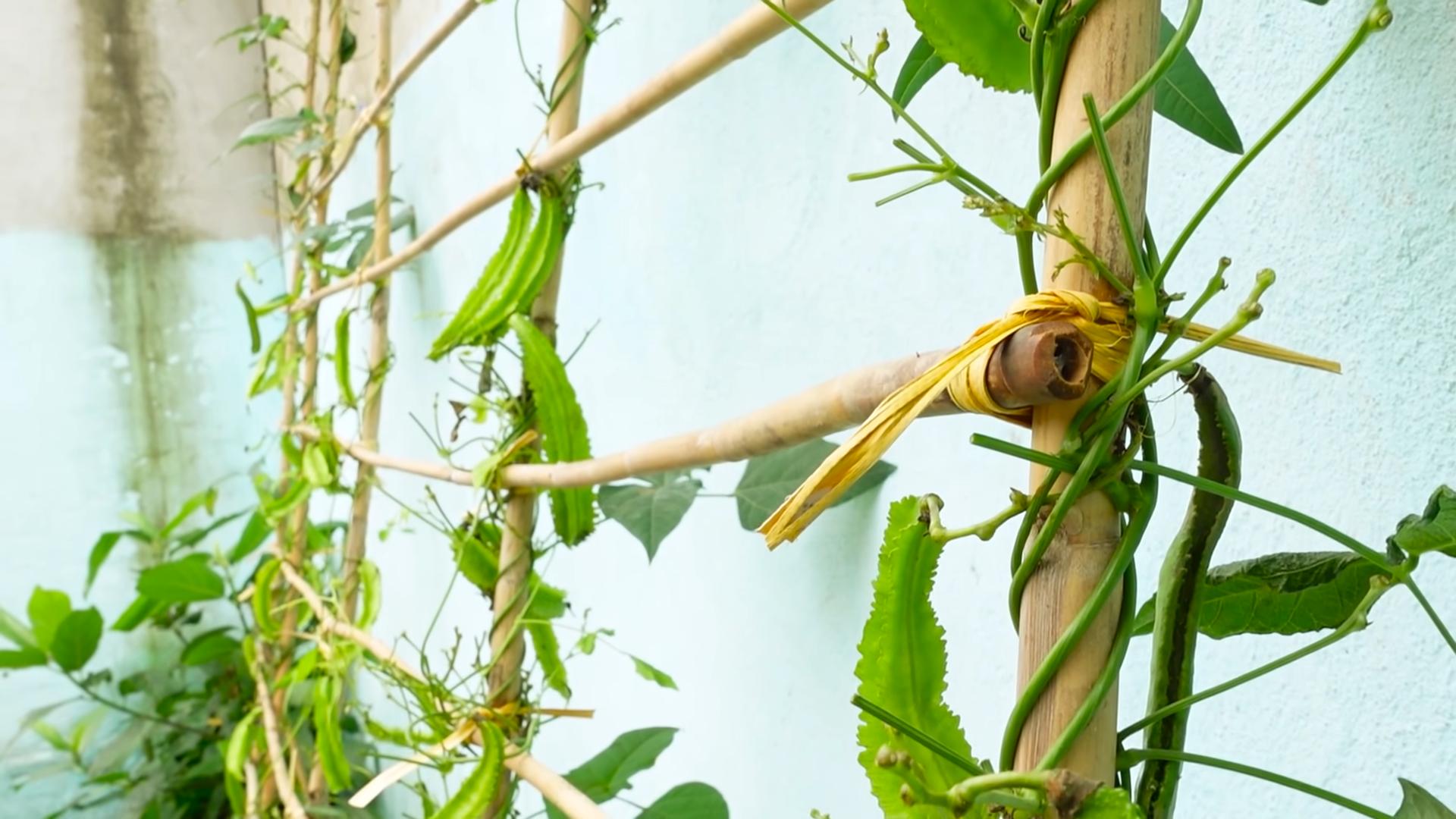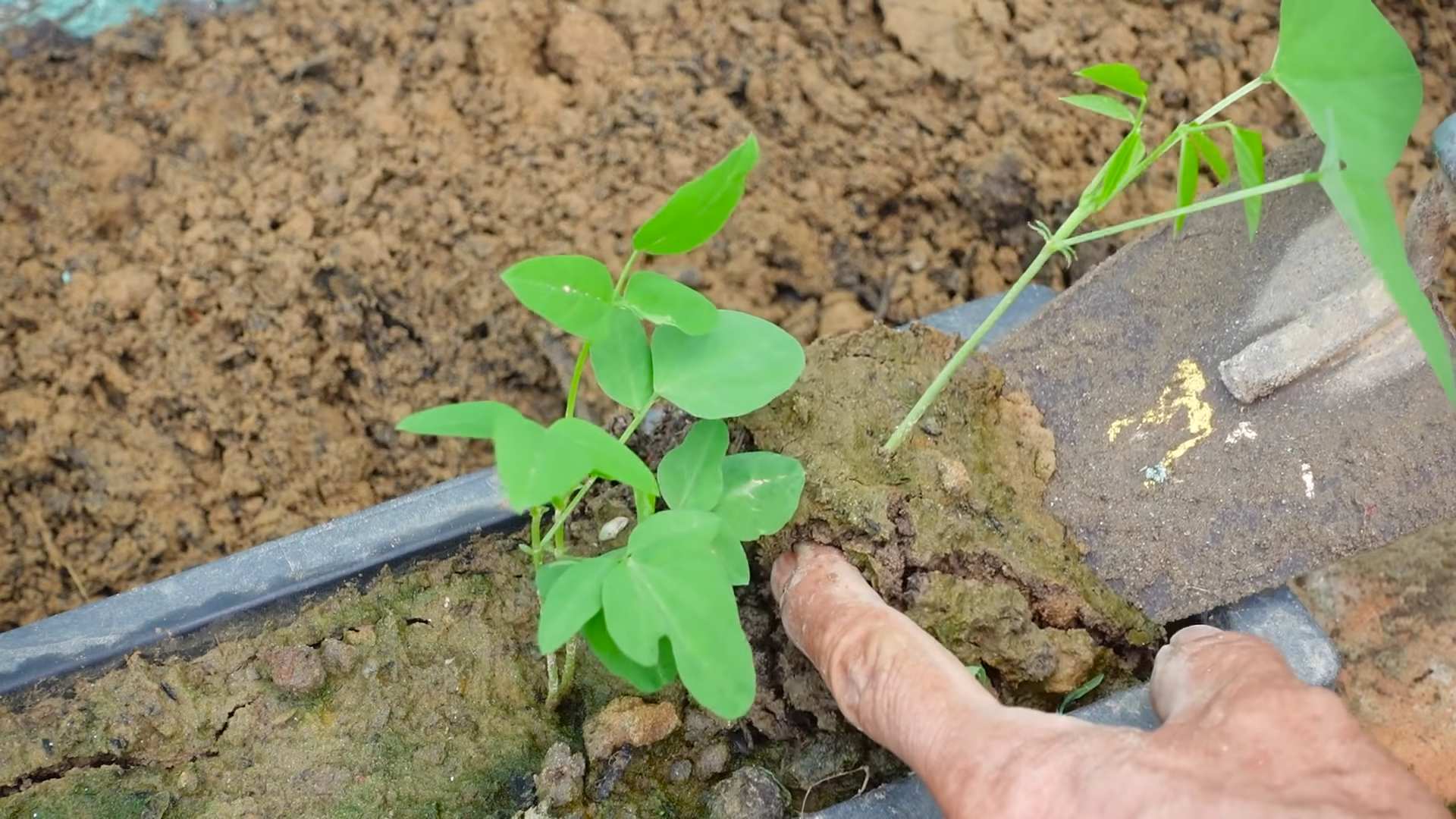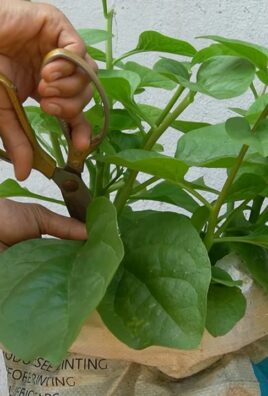Growing Dragon Beans might sound like something straight out of a fantasy novel, but I promise you, it’s a real and rewarding gardening adventure! Have you ever dreamed of adding a touch of the exotic to your backyard, something that not only tastes delicious but also looks absolutely stunning? Well, look no further! This DIY guide is your passport to cultivating these vibrant and vigorous climbers, transforming your garden into a lush, edible landscape.
While Dragon Beans (also known as Asparagus Beans or Yardlong Beans) don’t have a deeply rooted historical significance like some heirloom vegetables, their popularity has spread across cultures, particularly in Asian cuisine. They’ve been enjoyed for generations in stir-fries, salads, and countless other dishes. Their impressive length and unique flavor have made them a staple in many gardens and kitchens.
But why should you embark on this growing Dragon Beans journey? In today’s world, where we’re increasingly conscious of where our food comes from, cultivating your own vegetables offers a sense of control, satisfaction, and connection to nature. Plus, let’s be honest, who wouldn’t want to impress their friends and family with these extraordinary beans? This DIY article will equip you with all the essential tips and tricks to successfully grow these fascinating legumes, even if you’re a beginner gardener. Get ready to unleash your inner green thumb and harvest a bounty of delicious, eye-catching Dragon Beans!

Growing Dragon Beans: A DIY Guide to a Bountiful Harvest
Hey there, fellow gardening enthusiasts! I’m so excited to share my experience with growing dragon beans. These aren’t your average green beans; they’re long, vibrant, and absolutely delicious. Plus, the plants are stunning climbers, adding a touch of drama to any garden. I’ve learned a few tricks along the way, and I’m here to guide you through the entire process, from seed to table.
Understanding Dragon Beans
Before we dive in, let’s talk a little about what makes dragon beans so special. Also known as yardlong beans or asparagus beans, they’re a type of cowpea, not actually a true bean. They thrive in warm weather and need plenty of sunshine. The beans themselves can grow up to three feet long (hence the name!), and they have a slightly nutty, slightly sweet flavor.
Getting Started: What You’ll Need
To successfully grow dragon beans, you’ll need a few essential items. Don’t worry, most of these are readily available at your local garden center or online.
* Dragon Bean Seeds: Choose a reputable supplier to ensure good germination rates. Look for varieties that are well-suited to your climate.
* Well-Draining Soil: Dragon beans prefer soil that’s rich in organic matter and drains well. You can amend your existing soil with compost or aged manure.
* Trellis or Support Structure: These beans are climbers, so they need something to grow on. A trellis, fence, or even a sturdy teepee will work.
* Watering Can or Hose: Regular watering is crucial, especially during hot weather.
* Fertilizer: A balanced fertilizer will help your plants thrive. I prefer using an organic fertilizer.
* Gardening Gloves: Protect your hands from dirt and potential irritants.
* Hand Trowel or Shovel: For planting and transplanting.
* Optional: Seed starting trays, heat mat (for starting seeds indoors).
Phase 1: Starting Your Seeds (Optional)
While you can directly sow dragon bean seeds into the ground, I’ve found that starting them indoors gives them a head start, especially if you live in an area with a shorter growing season.
1. Choose Your Seed Starting Method: You can use seed starting trays, peat pots, or even recycled egg cartons. Just make sure whatever you choose has drainage holes.
2. Fill with Seed Starting Mix: Use a light, sterile seed starting mix to prevent fungal diseases.
3. Sow the Seeds: Plant the seeds about 1 inch deep and 2 inches apart.
4. Water Gently: Moisten the soil without overwatering. You want it damp, not soggy.
5. Provide Warmth: Dragon bean seeds germinate best in warm temperatures (around 70-80°F). A heat mat can be helpful.
6. Provide Light: Once the seedlings emerge, they’ll need plenty of light. Place them under grow lights or in a sunny window.
7. Harden Off: Before transplanting your seedlings outdoors, you’ll need to harden them off. This means gradually exposing them to outdoor conditions over a period of about a week. Start by placing them outside for an hour or two each day, gradually increasing the time.
Phase 2: Planting Dragon Beans Outdoors
Once the danger of frost has passed and the soil has warmed up, it’s time to plant your dragon beans outdoors.
1. Choose a Sunny Location: Dragon beans need at least 6-8 hours of sunlight per day.
2. Prepare the Soil: Amend the soil with compost or aged manure to improve drainage and fertility.
3. Install Your Trellis: Make sure your trellis or support structure is sturdy and well-anchored. Dragon bean plants can get quite heavy when they’re loaded with beans.
4. Plant the Seeds or Seedlings: If you’re direct sowing, plant the seeds about 1 inch deep and 4-6 inches apart. If you’re transplanting seedlings, space them about 6-8 inches apart.
5. Water Thoroughly: After planting, water the soil thoroughly.
6. Mulch (Optional): Applying a layer of mulch around the plants can help retain moisture and suppress weeds. I like to use straw or wood chips.
Phase 3: Caring for Your Dragon Bean Plants
Once your dragon bean plants are established, it’s important to provide them with the care they need to thrive.
1. Water Regularly: Dragon beans need consistent moisture, especially during hot weather. Water deeply whenever the top inch of soil feels dry. Avoid overhead watering, as this can promote fungal diseases.
2. Fertilize: Fertilize your plants every few weeks with a balanced fertilizer. Follow the instructions on the fertilizer package.
3. Provide Support: As your plants grow, they’ll need help climbing the trellis. Gently guide the vines and tie them to the support structure as needed.
4. Pest Control: Keep an eye out for pests such as aphids, bean beetles, and spider mites. If you spot any pests, treat them with an appropriate insecticide or organic pest control method. I prefer using insecticidal soap or neem oil.
5. Weed Control: Regularly remove weeds from around your plants. Weeds can compete with your dragon beans for nutrients and water.
6. Pruning (Optional): While not essential, pruning can help improve air circulation and encourage bushier growth. You can prune off any yellowing or damaged leaves.
Phase 4: Harvesting Your Dragon Beans
The best part of growing dragon beans is, of course, harvesting them!
1. Harvest Time: Dragon beans are typically ready to harvest about 60-80 days after planting.
2. Look for the Right Size: Harvest the beans when they’re about 12-18 inches long and still tender. They should snap easily when bent.
3. Harvest Regularly: The more you harvest, the more beans your plants will produce. Harvest every few days to keep the plants producing.
4. Use Scissors or Pruners: Cut the beans from the vine using scissors or pruners. Be careful not to damage the plant.
5. Enjoy Your Harvest: Dragon beans can be eaten raw, steamed, stir-fried, or added to soups and stews. They’re a versatile and delicious vegetable.
Troubleshooting Common Problems
Even with the best care, you might encounter a few problems while growing dragon beans. Here are some common issues and how to address them:
* Poor Germination: If your seeds aren’t germinating, make sure the soil is warm enough and that you’re not overwatering. You can also try soaking the seeds in water for 24 hours before planting.
* Yellowing Leaves: Yellowing leaves can be a sign of nutrient deficiency, overwatering, or pest infestation. Check the soil moisture, fertilize your plants, and inspect them for pests.
* Lack of Flowers: If your plants aren’t flowering, it could be due to lack of sunlight, poor soil, or excessive nitrogen fertilizer. Make sure your plants are getting enough sunlight, amend the soil with compost, and use a balanced fertilizer.
* Pest Infestation: As mentioned earlier, keep an eye out for pests and treat them promptly.
* Disease: Fungal diseases can be a problem in humid conditions. Ensure good air circulation around your plants and avoid overhead watering. If you spot any signs of disease, treat your plants with a fungicide.
Tips for a Bountiful Harvest
Here are a few extra tips to help you maximize your dragon bean harvest:
* Succession Planting: Plant a new batch of seeds every few weeks to extend your harvest season.
* Companion Planting: Plant dragon beans alongside beneficial companion plants such as marigolds, basil, and rosemary. These plants can help deter pests and attract pollinators.
* Water Deeply: When watering, water deeply and less frequently rather than shallowly and more often. This encourages deep root growth.
* Provide Adequate Support: Make sure your trellis or support structure is strong enough to support the weight of the plants and the beans.
* Harvest Regularly: As mentioned earlier, the more you harvest, the more beans your plants will produce.
Storing Your Dragon Beans
If you have more dragon beans than you can eat, you can store them in the refrigerator for up to a week. You can also freeze them for longer storage. To freeze dragon beans, blanch them in boiling water for 2-3 minutes, then plunge them into ice water to stop the cooking process. Drain the beans and store them in freezer bags or containers.
Enjoying Your Homegrown Dragon Beans
Now that you’ve successfully grown and harvested your own dragon beans, it’s time to enjoy them! These versatile beans can be used in a variety of dishes

Conclusion
So, there you have it! Growing dragon beans isn’t just a gardening project; it’s an adventure in flavor, a visual spectacle, and a rewarding experience that connects you directly to the source of your food. We’ve walked you through the process, from selecting the right seeds to harvesting those impressive, vibrant pods. But why should you take the plunge and dedicate space in your garden to these magnificent legumes?
Firstly, the taste is unparalleled. Forget bland, store-bought green beans. Dragon beans offer a unique, slightly sweet, and subtly earthy flavor that elevates any dish. Whether you’re steaming them, stir-frying them, or adding them to a hearty stew, their distinctive taste will shine through.
Secondly, the visual appeal is undeniable. Imagine the striking contrast of the purple streaks against the green pods, climbing gracefully up a trellis or fence. Dragon beans are not just food; they’re a living work of art that will add beauty and interest to your garden. They are a conversation starter and a source of pride for any gardener.
Thirdly, growing your own dragon beans is incredibly satisfying. There’s nothing quite like the feeling of nurturing a plant from seed to harvest and then enjoying the fruits (or, in this case, the beans) of your labor. It’s a tangible connection to nature and a reminder of the simple pleasures in life.
But the benefits don’t stop there. Growing your own food, especially something as unique as dragon beans, reduces your reliance on commercially grown produce, which often travels long distances and may be treated with pesticides. You have complete control over the growing process, ensuring that your beans are healthy, organic, and bursting with flavor.
Ready to take your dragon bean cultivation to the next level? Consider these variations:
* Vertical Gardening: Dragon beans are natural climbers, making them perfect for vertical gardening. Train them up trellises, fences, or even teepees to create a stunning visual display and maximize your garden space.
* Companion Planting: Plant dragon beans alongside other beneficial plants, such as marigolds (to deter pests) or basil (to improve flavor).
* Succession Planting: Plant dragon beans in stages throughout the growing season to ensure a continuous harvest.
* Seed Saving: Save seeds from your best-performing plants to ensure a consistent supply of high-quality seeds for future seasons.
We encourage you to embark on this exciting gardening journey and discover the joys of growing your own dragon beans. Don’t be afraid to experiment, adapt the techniques to your specific climate and growing conditions, and most importantly, have fun!
Once you’ve harvested your first crop of dragon beans, we’d love to hear about your experience. Share your photos, recipes, and tips in the comments below. Let’s create a community of dragon bean enthusiasts and inspire others to discover the magic of these remarkable legumes. So, get your hands dirty, plant those seeds, and prepare to be amazed by the beauty and flavor of homegrown dragon beans! This DIY project is more than just gardening; it’s a culinary adventure waiting to happen.
Frequently Asked Questions (FAQ)
What exactly are dragon beans, and are they different from other types of beans?
Dragon beans, also known as dragon tongue beans or borlotti beans, are a type of heirloom bean prized for their striking appearance and unique flavor. Unlike common green beans, dragon beans have distinctive purple streaks on their pods, which fade when cooked. Their flavor is slightly sweeter and earthier than typical green beans, making them a versatile ingredient in various dishes. They are also known for their creamy texture when cooked.
How much sunlight do dragon beans need to grow successfully?
Dragon beans thrive in full sunlight, requiring at least 6-8 hours of direct sunlight per day. Insufficient sunlight can lead to stunted growth, reduced yields, and pale pods. Choose a sunny location in your garden with well-draining soil to ensure optimal growth. If you live in a particularly hot climate, some afternoon shade can be beneficial to prevent the plants from overheating.
What type of soil is best for growing dragon beans?
Dragon beans prefer well-draining, fertile soil with a slightly acidic to neutral pH (around 6.0 to 7.0). Amend heavy clay soil with compost or other organic matter to improve drainage and aeration. Sandy soil can be improved by adding compost or peat moss to increase its water-holding capacity. A soil test can help determine the pH and nutrient levels of your soil, allowing you to make necessary adjustments before planting.
How often should I water my dragon bean plants?
Water dragon bean plants regularly, especially during dry periods. Aim to keep the soil consistently moist but not waterlogged. Water deeply at the base of the plants, avoiding wetting the foliage, which can increase the risk of fungal diseases. Mulching around the plants can help retain moisture and suppress weeds. As the plants mature and the pods begin to develop, you may need to increase watering frequency.
What are some common pests and diseases that affect dragon beans, and how can I prevent them?
Common pests that can affect dragon beans include aphids, bean beetles, and spider mites. Diseases include bean rust, powdery mildew, and anthracnose. To prevent these problems, practice good garden hygiene, such as removing plant debris and weeds. Inspect your plants regularly for signs of pests or diseases and take action promptly. Organic pest control methods, such as insecticidal soap or neem oil, can be effective against many common pests. Ensure good air circulation around the plants to reduce the risk of fungal diseases. Crop rotation can also help prevent soilborne diseases from building up.
When is the best time to harvest dragon beans?
Harvest dragon beans when the pods are plump, firm, and the purple streaks are still visible. The beans inside should be well-formed but not overly mature. Regular harvesting encourages continued production. You can also harvest the beans when they are fully mature and dry them for use as dried beans.
Can I grow dragon beans in containers?
Yes, dragon beans can be grown in containers, but you’ll need to choose a large container (at least 12 inches in diameter) with good drainage. Use a high-quality potting mix and provide a trellis or other support for the plants to climb. Container-grown dragon beans may require more frequent watering and fertilization than those grown in the ground.
How do I save seeds from my dragon bean plants?
To save seeds from your dragon bean plants, allow some of the pods to fully mature and dry on the vine. Once the pods are completely dry and brittle, shell the beans and spread them out on a tray to dry further for a few days. Store the dried beans in an airtight container in a cool, dry place. Label the container with the variety and date.
Are dragon beans a good source of nutrients?
Yes, dragon beans are a good source of nutrients, including fiber, protein, vitamins, and minerals. They are low in calories and fat and are a healthy addition to any diet. They are particularly rich in folate, manganese, and vitamin C.
What are some delicious ways to cook and enjoy dragon beans?
Dragon beans can be cooked in a variety of ways. They can be steamed, boiled, stir-fried, or added to soups and stews. Their unique flavor pairs well with garlic, herbs, and spices. Try them in salads, pasta dishes, or as a side dish. They can also be used to make dips and spreads. Experiment with different recipes to discover your favorite way to enjoy these versatile beans.




Leave a Comment